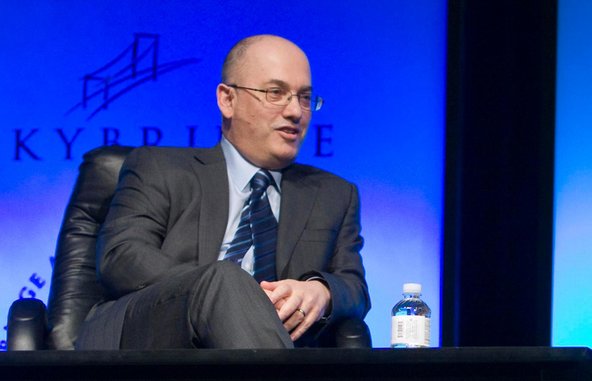 Steve Marcus/ReutersSteven Cohen’s lawyers may not have seen the possibility of administrative charges by the S.E.C.
Steve Marcus/ReutersSteven Cohen’s lawyers may not have seen the possibility of administrative charges by the S.E.C.
“We’re willing to pay $600 million because we have a business to run and don’t want this hanging over our heads with litigation that could last for years.”
That’s what Steven A. Cohen’s lawyer told a judge just four months ago to justify why Mr. Cohen had agreed to pay $616 million to the Securities and Exchange Commission to settle civil accusations that his firm was involved in insider trading without admitting or denying guilt.
DealBook Column
View all posts
Related Links
If that explanation sounded like a payoff — “buying off the U.S. government” is the way John Cassidy of The New Yorker put it at the time — that’s because, with hindsight, that’s what it was.
But it didn’t work.
The S.E.C., having been shamed by critics for making what seemed like a deferential deal, returned with a new civil action against Mr. Cohen individually on Friday, seeking to bar him from the industry.
The new charges and evidence raise all sorts of questions. But within the legal community, one question is now particularly baffling: Why did Mr. Cohen pay more than half a billion dollars to settle a case that now appears far from settled?
“It’s hard to believe he got bad advice. It’s not like he’s using some street-corner lawyer,” said Jacob S. Frenkel, a former S.E.C. enforcement lawyer who is now a partner at Shulman Rogers Gandal Pordy Ecker.
Within Mr. Cohen’s legal camp, which includes Paul, Weiss and Willkie Farr, the new civil action came as a surprise, according to people involved in the case. His legal team had thought that by settling with the S.E.C. in March for such a large sum it would be unlikely that the agency would come back for more, despite assertions by the S.E.C. that it reserved the right to pursue additional charges against Mr. Cohen.
At minimum, Mr. Cohen’s lawyers thought they had strong evidence that would help them talk the S.E.C. out of bringing a fraud charge against their client, these people said. In that regard, they succeeded. But they never imagined the S.E.C. would bring an administrative claim of “failure to supervise” against Mr. Cohen, which, to their way of thinking, would be an admission of defeat by the S.E.C. because it would be perceived as a demonstration of weakness, the equivalent of charging Al Capone with tax evasion.
“The S.E.C. created expectations in the settlement by strong inference,” Mr. Frenkel said. “There is an expectation of reasonable closure.”
But Mr. Cohen’s lawyers — and perhaps everyone else — missed the larger picture: The S.E.C.’s “failure to supervise” case can still have the same effect as a more damning fraud charge because it has the potential to put his firm out of business.
When Mr. Cohen’s $616 million settlement was first presented to Judge Victor Marrero of Federal District Court in Manhattan, he resisted approving it, saying aloud what so many people were thinking at the time, “There is something counterintuitive and incongruous about settling for $600 million if it truly did nothing wrong.”
What Judge Marrero didn’t appreciate — and what the public may have missed as well — was the math behind why the whopping settlement arguably made sense if it would end the years-long investigation into Mr. Cohen.
The goal of the settlement, and its timing, were clearly aimed at assuaging nervous investors in Mr. Cohen’s fund so that they wouldn’t seek the return of their money. Mr. Cohen managed $15 billion, including about $9 billion of his money and other employees’. The remaining $6 billion comes from outside investors — and it is worth big fees to the firm. Mr. Cohen collects a 3 percent “management fee” and takes upward of 50 percent of profits. On $6 billion, if you follow the math, annual management fees collected can total as much as $180 million. If the firm can produce profits of as little as 10 percent, the firm can collect $300 million more. If the firm produces more than 30 percent returns, its historical average, the fees could jump to over $1 billion.
Consequently, a settlement payment of $616 million could pay for itself in a year or two.
That was then. Now, that $616 million settlement appears to be a down payment on a much longer soap opera that could still include a criminal case down the road.
When Mr. Cohen made his original settlement agreement, the S.E.C.’s leadership was in transition, a clear red flag from a tactical perspective. With the addition of Mary Jo White a month after the deal was reached, she pressed to continue the inquiry, and ultimately, the new action.
While the S.E.C. under Ms. White clearly didn’t rescind its previous agreement, the new civil action could have one adverse outcome: it could make the agency’s job more complicated in future investigations.
“This could impact the approach to cooperation,” Mr. Frenkel said. “You have to believe whatever ambiguities existed were intentional on the S.E.C.’s part. It calls into question whether the agency negotiated in good faith.”
Maybe so. But after years of Wall Street executives appearing to outnegotiate the S.E.C., it finally seems as if the agency won a round.
Andrew Ross Sorkin is the editor-at-large of DealBook. Twitter: @andrewrsorkin
A version of this article appeared in print on 07/23/2013, on page B1 of the NewYork edition with the headline: A Towering Fine For Naught, As the S.E.C. Tracks Cohen.
Article source: http://dealbook.nytimes.com/2013/07/22/a-towering-fine-for-naught-as-the-sec-tracks-cohen/?partner=rss&emc=rss


